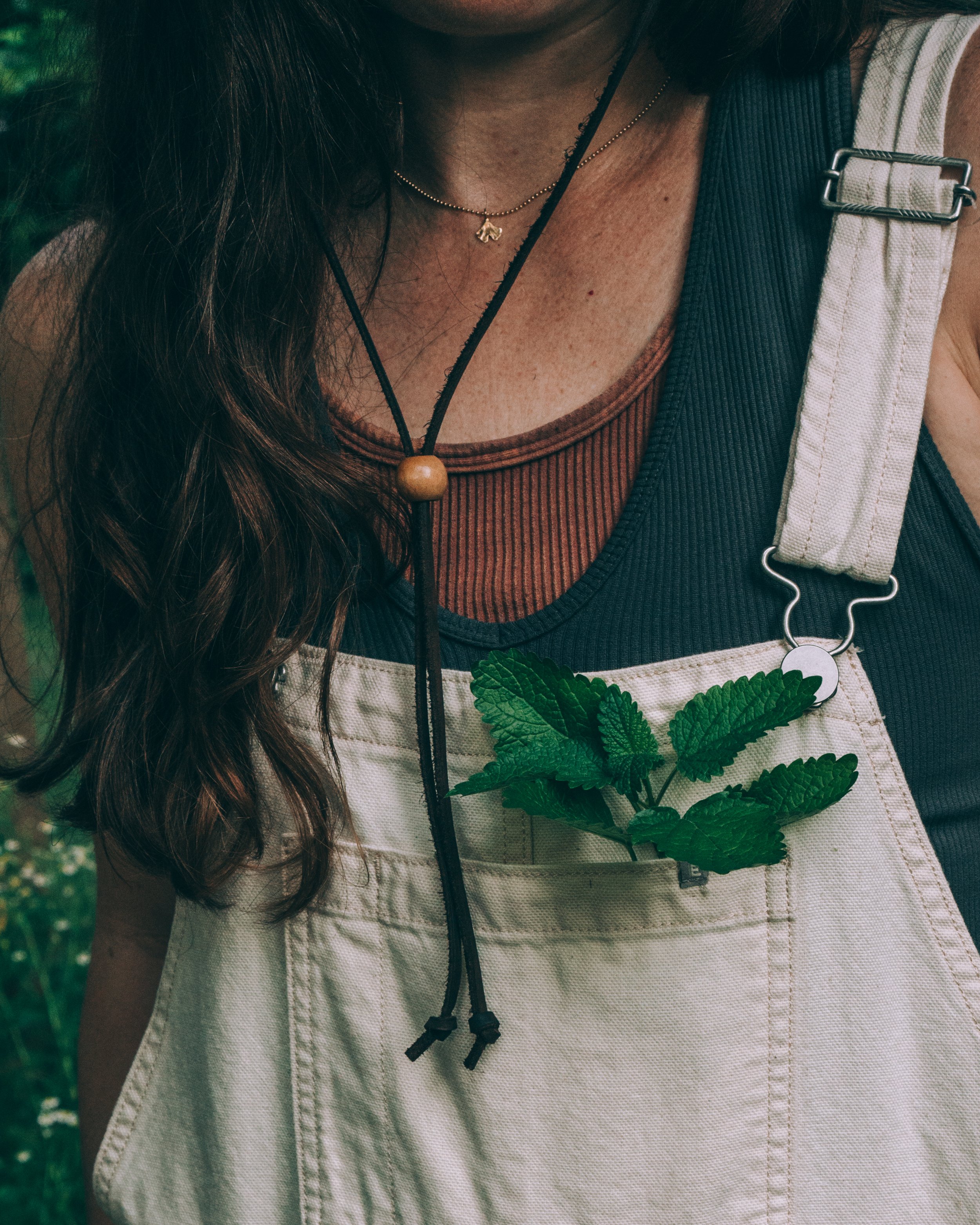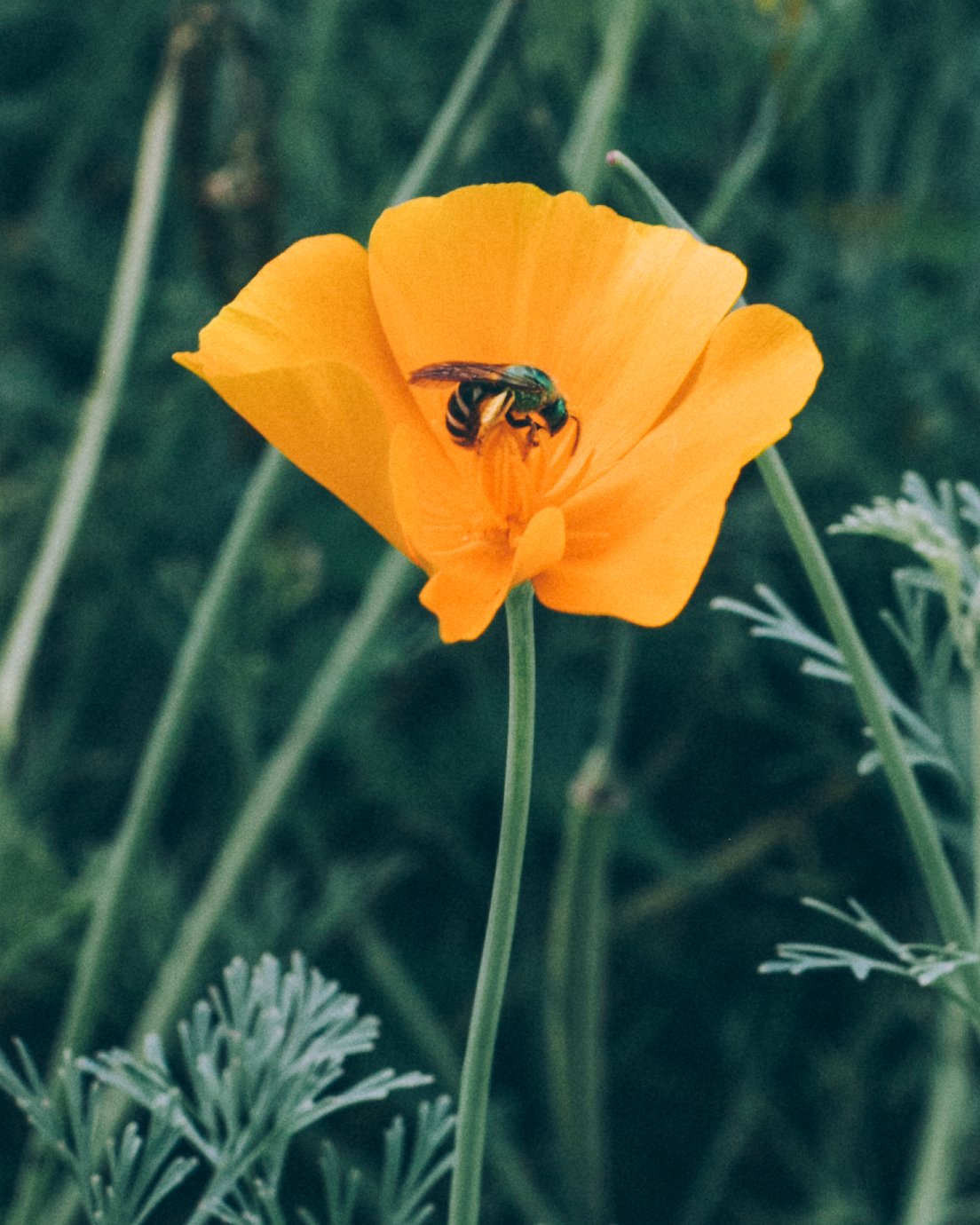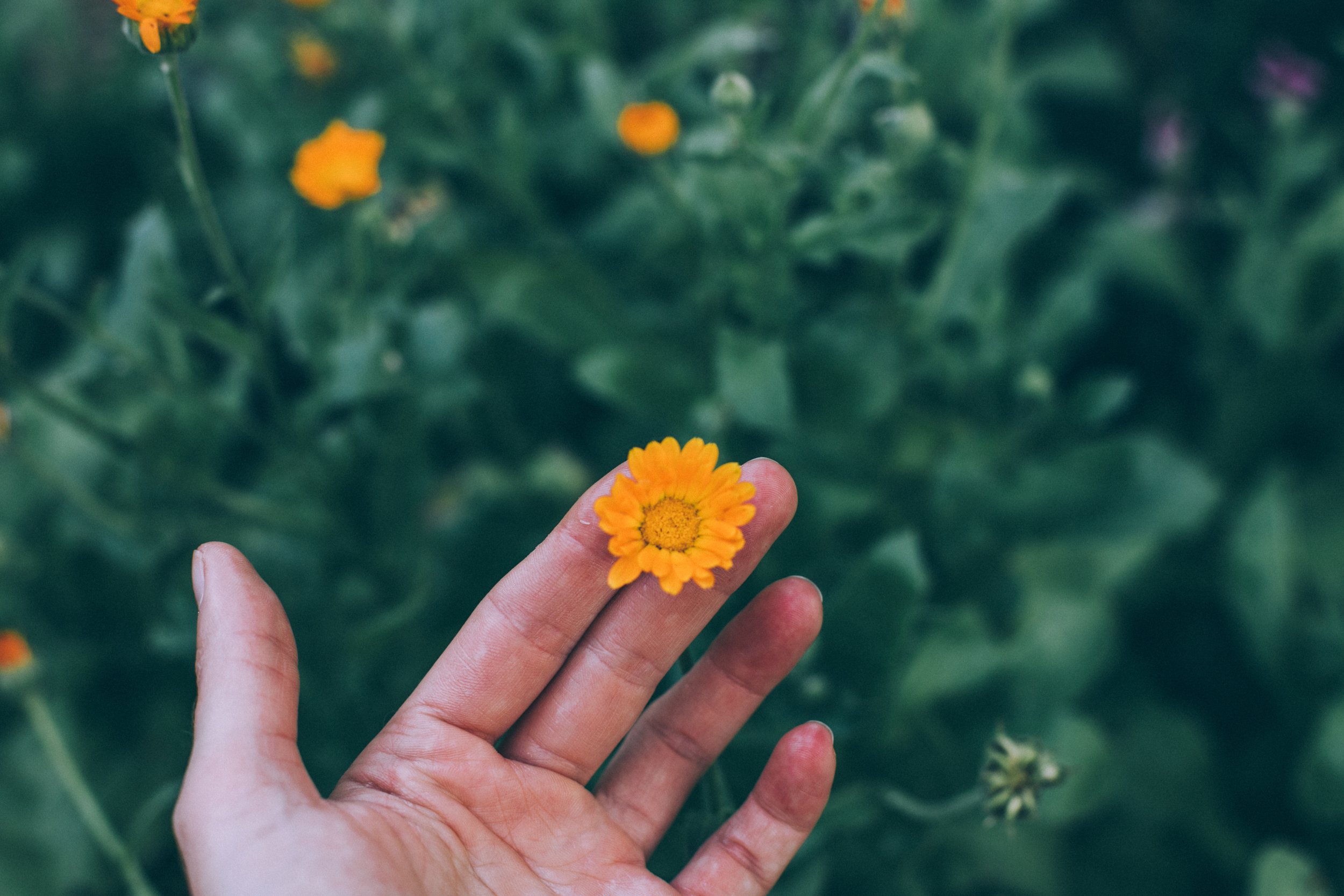My Favorite Plants for a Medicinal Herb Garden
In addition to wildcrafting, tending your own medicinal herb garden is a beautiful and time-tested way to forge a deeper relationship with the plants you use. Not only will you begin working with plant material that’s more vibrant, sensual, and alive than anything you can purchase online, but you will also begin to experience “ah-ha” moments as the living plants impart their wisdom.
For example, you may know that sage (Salvia officinalis) is considered cooling to the body. Perhaps you’ve already memorized this fact and written it down somewhere. You may remember it next time you think about sage, or you may not. But imagine this instead: You’re working in the garden on a hot afternoon and you brush against a vibrant sage plant. You’re struck at how cool the leaves really do feel against your skin. In this moment, the fact that you wrote down becomes knowledge that’s interwoven with your own first-hand experiences and memories. This type of natural plant communication will ground and inspire your herbal studies for years to come!
Creating a medicinal herb garden is accessible even if you have a small space and tight budget. Plus, growing or ethically foraging your own plants is much more sustainable than purchasing herbs online, which have to be packaged (usually in plastic) and shipped halfway across the world.
Another noteworthy benefit of growing your own herbs is that you will also have an abundance of plant material to use and share! Many herbs are wild, unfussy spirits that expand and flourish with each passing year. Before you know it, you’ll be sharing seeds and seedlings with your community and pressing bottles of your own infused oils, tinctures, and tea blends into friends’ hands. You’ll quickly learn that the plants want to grow in your garden and share their wisdom with you—they’re happy that you’re (re)joining an ancient conversation between humans and plants.
As you can see, I’m a huge fan of growing your own medicinal herbs. It’s transformed my life in the most wonderful ways, and many of the herbs that I use in the Hawthorn & Honey goods come from my own gardens. After years of tending my herb garden, here are the plants that I believe are a lovely fit for herb gardeners of all skill levels. I’ve organized them into the categories for which they’re often associated with (digestion, sleep, etc.); however, many of these herbs have dozens, if not hundreds of other uses that I encourage you to research as well. One of the beauties of herbalism is that it’s a folk art with so much to uncover!
Herbs for Mood
Holy Basil (Tulsi)
Holy basil, which is also known as tulsi (Ocimum spp.) is a gently uplifting herb that has been shown to “significantly” ease anxiety in clinical trials. Holy basil is in the mint family, and the slightly spicy, almost bubble-gum like flavor of the leaves is absolutely delicious in tea blends, among other things.
To grow: This much-loved herb is native to South Asia, which helps explain why it prefers warm days and does not tolerate frost at all. Holy basil grows best in rich, moist soil in the sun or partial shade. It readily self-seeds, so you will most likely have new seedlings pop up in your garden each year after it’s established.
Holy basil is niche enough that you may not find it at your local nursery. A variety of holy basil seeds and live seedlings are available online via Strictly Medicinal Seeds, and the temperate variety (Ocimum africanum) seems to be the one that gardeners across the United States have the most success with.
Lemon balm
Lemon balm (Melissa officinalis) is easy to grow in a variety of climates and, as the name suggests, the leaves have a pleasant lemony flavor. Truly a balm to the spirit, lemon balm has been used for centuries to help uplift the mood, soothe anxiety, and ease nervousness. This delightful herb also has an affinity for the digestive system, so it’s a particularly lovely choice for folks who experience digestive upset when they’re stressed or nervous. Lemon balm is often prepared as a tea, tincture, or infused honey. I absolutely love adding fresh lemon balm sprigs to a pitcher of sun tea on hot summer days!
To grow: It’s best to start lemon balm from established seedlings, so look for starts at your local plant nursery. Lemon balm is not fussy and it will grow nearly anywhere, but it does prefer rich, well-drained soil and full sun. As a perennial, lemon balm will die back in winter and then peak up with fresh greenery each spring. After it’s established you can look forward to enjoying it for years to come!
Rose
Rose (Rosa spp.) gladdens the heart with a single sniff. Just the thought of dew-covered wild rose brambles brings a smile to my face. Rose has historically been used to help ease the emotional pain of grief and heartbreak, and the thorns help remind us to honor our instincts and set boundaries. As a cooling nervine, rose can be a natural source of comfort and a reminder of love - the most powerful medicine of all. Rose petals are delicious in teas, tinctures, glycerines, honeys, and more.
To grow: There are more than 100 species of roses and 18,000 cultivars! Roses with the longest history of medicinal use are the Damask rose (Rosa x damascena) and the apothecary rose (Rosa gallica). Do not choose a “self-cleaning” rose variety - this means they will not develop rose hips, but the Vitamin C-packed rose hips are beloved by herbalists worldwide.
Roses are perennials, which means they’ll come back each year; however, they can be a bit fussy, especially compared to the low-maintenance nature of many herbs. In spring or fall, plant your roses in a sunny, well-drained spot. Most rose varieties will need to be watered consistently throughout the growing season, and they will create more blooms if you fertilize regularly. Each spring, prune your rose bush by removing any dead or damaged canes.
Herbs for Sleep
Passionflower
A beautiful addition to any medicinal herb garden, passionflower, also known as maypop (Passiflora incarnata), is a vining herb that will adorn your gates and trellises with eye-catching purple flowers throughout summer. Folks used passionflower root throughout much of history, but today herbalists primarily use the leaves and flowers in teas or tinctures to help promote a restful night’s sleep, among other things.
To grow: You can start passionflower seeds indoors 6-8 weeks before your average last frost, or plant the seeds directly in your garden after all danger of frost has passed. Passionflower prefers full sun, rich, moist soil, and regular watering. Passionflower is not a very fussy plant, and in warmer parts of the country it can even become invasive.
Because it’s a vine, passionflower needs to be planted near a trellis or gate so that it can climb and stretch throughout summer. Harvest the beautiful purple flowers as soon as you see them—they only bloom for a day or two before fading. Toward the end of summer, let a few of the flowers turn to fruit and then fall from the vine to naturally reseed and sprout again next year.
California Poppy
Another sun-loving herb, California poppy (Eschscholzia californica) is native to the western United States and its buttery orange flowers are synonymous with California’s hillsides. This lovely flower is used by herbalists to help calm the spirit and encourage a restful night’s sleep. It also has gentle pain-relieving (analgesic) properties, so it’s a particularly thoughtful choice for folks who are having trouble sleeping due to occasional pain, like seasonal headaches or period-related cramps.
To grow: It’s best to sprinkle California poppy seeds directly into a prepared, sunny site after all danger of frost has passed. Press the seeds into the soil and keep them well watered until they sprout, which should happen within two weeks. Thin the seedlings to about 8 inches apart, and then watch them flourish with time. California poppy is remarkably drought tolerant, so it does not need to be watered heavily, and it will do best in well-drained, even sandy soil
Skullcap
Skullcap (Scutellaria lateriflora) is another perennial herb in the mint family. The leaves, stems, and purple flowering tops are traditionally used in teas and tinctures to help soothe nervous tension so you can slip into a deep, restorative sleep.
To grow: Skullcap may not be available at your local plant nurseries, so you may need to purchase the seed or seedlings from an online supplier, like Strictly Medicinal Seeds. Sow the seeds directly outdoors in fall or early spring, keep well watered until the seeds germinate, then thin the seedlings to approximately 12 inches apart. Skullcap is naturally found in woodlands and along stream banks, which helps explain why it grows best when planted in partial shade and moist, well-drained soil.
Digestion
German Chamomile
This beloved herb has withstood the test of time for a reason. Chamomile (Matricaria chamomilla) predates written history, and the flowers were found in scrapings from a set of 50,000-year-old Neanderthal teeth discovered in Spain. Herbalists regularly turn to chamomile for its ability to help soothe occasional cramping and digestive discomfort along with minor stress and tension. Chamomile has a sweet, apple-like flavor that is universally enjoyed by adults and children alike.
To grow: Chamomile can be seeded directly in the garden in fall or early spring. It prefers cool weather and the flowers will typically fade if the weather gets too hot. If you live in Zone 6 or warmer, you may see the best results if you sow your chamomile seeds (or plant your seedlings) in fall. They’re very cold-tolerant and should over-winter just fine, coming back strong in early spring to bloom before the summer heat sets in.
(Roman chamomile (Chamaemelum nobile) has similar uses and growing needs; however, it’s a perennial and does not get as tall as German chamomile.)
Catnip
Catnip (Nepata cataria) is well known for making cats excited, but it has the opposite effect on humans! Safe for adults and children alike, catnip is traditionally turned to for its slightly sedative properties and its ability to help ease gas and soothe digestive upset, among other things. A member of the mint family, catnip leaves have a unique flavor that’s reminiscent of mint and citrus and works well in teas and tinctures.
To grow: Another member of the mint family, catnip is a perennial with soft, downy leaves and small purplish flowers. It can be planted from seed or seedling, although in many places it just pops up naturally in the garden when it’s ready to be included. Catnip grows best in well-draining soil in full to partial sun. It’s hardy and easy to grow, you’ll only need to water it if it’s in a pot or if you have an extended period of dryness or drought.
Peppermint
Like chamomile, peppermint (Mentha x piperita) has remained extremely popular throughout the centuries, and for good reason. It tastes delicious, grows vigorously, and helps ease a number of conditions related to digestive upset, nausea, pain, and nerves. Cooling peppermint is an all-star in tea blends, and its strong flavor helps mask the bitterness of other herbs that may be included for their medicinal value, but don’t necessarily taste great.
To grow: A classic addition to every medicinal herb garden, easy-to-grow peppermint is a hybrid, so it’s best to start it from an established seedling. Because peppermint is so common, you should easily find it at a local nursery or greenhouse. The main thing to keep in mind when growing peppermint (especially if you grow it in pots) is that it likes to be watered regularly. In the wild, it’s often found growing along streams and ponds where it can consistently drink up the moisture.
Mint spreads quickly and can easily take over an entire garden bed within a few years. Many gardeners choose to either dedicate a certain corner of their garden to mint or to grow it in pots to keep it contained. If you live in the South or Southwest United States, then you may want to consider growing spearmint (Mentha spicata) instead. (Spearmint has a similar flavor and related uses to peppermint but is more heat-tolerant.)
There’s an endless number of ways to get crafty with peppermint! From herbal recipes, like teas, tinctures, and infused oils, to culinary delights, like syrups, herbal sugars, sorbets, and more.
Skincare
Calendula
Calendula (Calendula officinalis) is one of the top herbs for skincare. Its golden yellow, resinous flowers bring joy to any garden, and it’s so easy to grow that even absolute beginners can reap the benefits of this cheerful flower’s presence.
Calendula is most often used externally to help soothe minor skin irritations, like cuts and scrapes, burns, blisters, bruises, sunburns, bites, and even fungal infections. Herbalists often infuse the sticky flowers in oil and then use the oil as-is or in a salve, cream, or soap. Calendula flowers are edible, and creative cooks will use them to adorn everything from cakes to salads.
To grow: Calendula is easy to start from seed, simply poke the seeds about 1/4 inch into rich, well-drained soil in full to partial sun after all danger of frost has passed. After they germinate, thin the seedlings to roughly 12 inches apart. Water regularly, and pick off the flowers heads as they bloom (this is called “deadheading” and will encourage the plant to create more flowers).
Toward the end of the year, leave the last batch of flowers on the plant so they can create seeds for next year. Pro tip: The birds will be just as excited about the seeds as you are, so you may want to poke the seeds safely into the soil in late fall or early winter so they’re ready to burst forth come spring.
Yarrow
Yarrow (Achillea millefolium) has a long history of being used to help soothe topical wounds. There are many reports of soldiers turning to yarrow in battle to help stop bleeding on the field, and the plant’s latin name, Achillea, is a reference to Achilles, the Greek hero who was reportedly dipped in a yarrow tea at birth to protect him in battle. Yarrow’s relationship with humans predates written history, and the fossilized flowers have even been found in 60,000 year-old Neanderthal burial sites.
Yarrow also has antiseptic, antibacterial, and pain-relieving properties. Many herbalists will dry and powder yarrow flowers, and then sprinkle the powder on wounds to stop bleeding, help disinfect the surface, and relieve minor discomfort. Fresh yarrow from the garden can also be applied as a quick and easy first-aid poultice.
To grow: Yarrow is drought-tolerant and grows in a wide variety of soils, so it’s a great addition to a beginner’s medicinal herb garden. For best results, start yarrow from seed indoors 6-8 weeks before your average last frost and then transplant the seedlings outside after all danger of frost has passed. Yarrow is a perennial, and after a few years you will have a dense, slowly expanding mass of white flowers on whispery, fern-like stems.
Comfrey
Comfrey (Symphytum officinale) is another fantastic herb for skincare. Herbalists often use comfrey compresses externally to help soothe minor sprains, swellings, and bruises. The main constituent in comfrey is allantoin, which stimulates tissue repair and helps to close wounds. In fact, the word “comfrey” comes from the Latin conferva, which means “to grow or boil together” (Herbal Academy’s comfrey monograph). This is a fascinating example of how traditional healers understood the uses for herbs far before we had clinical trials to “prove” their effectiveness. Safety note: Comfrey is so effective at knitting together wounds, that sometimes the wound can close too quickly and lock an infection inside. Always make sure to clean wounds very well before adding comfrey topically, and lean toward using comfrey on minor scrapes and cuts, nothing gaping.
To grow: With its large, lush leaves and purple, bell-shaped flowers, comfrey is a wonderful perennial addition to any medicinal herb garden. But be warned, comfrey loves to spread and can quickly take over an entire corner of your garden in just a few years! Keep an eye on it, and don’t hesitate to dig it up when needed. (Toss the extra leaves into your compost pile! Comfrey is notorious for helping to speed up the composting process and many gardeners grow it specifically for this purpose.)
It’s best to grow comfrey from a cutting or division. Ask your local herbalists whether anyone has a comfrey patch they need to thin out. Alternately, you can purchase live comfrey root cutting from Strictly Medicinal Seeds, here. Comfrey prefers full sun and regular, well-drained garden soil. After the first leaves poke up from the soil surface you’re off! Water regularly, and keep an eye on it so it doesn’t take over your garden.
In Closing,
I hope you find as much joy from starting a medicinal herb garden as I have! I’d love to see photos of your progress on Instagram, and don’t hesitate to send me a herb gardening question or tag me @HawthornAndHoney. It’s such a pleasure to see herb gardens sprouting up throughout the world and adding whimsy at every turn.
So much of the wisdom that I’ve gained from my garden over the years has come in the form of plant communication. I'm enchanted and ever-changed by the experience of learning directly from the plants, and I believe passionately in making that information available and accessible for others.
If communicating with the plants is something that sparks your curiosity or you’d like to learn more about, then I hope you’ll enjoy reading my Free Plant Communication Ebook, where I’ve compiled years of learning into one, accessible spot.










